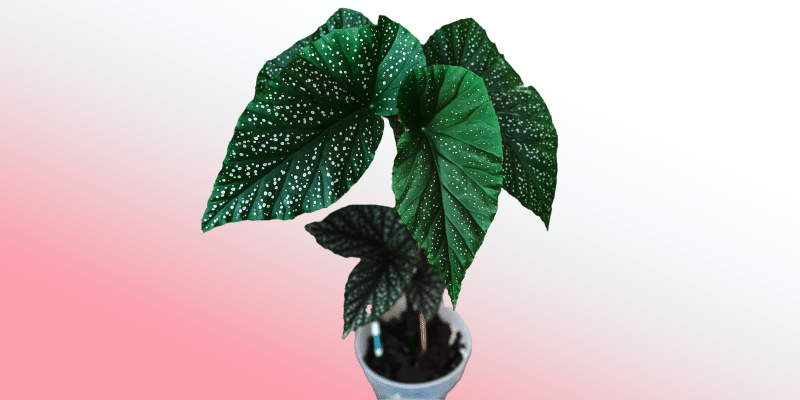Angel wing begonias are an absolute delight as an indoor plant. They’re perennial flowering plants, so they stick around for more than one year, and sport striking leaves with metallic decorations for when the flowers fade away.
We’ll cover propagating angel wing begonias from stem cuttings, how to deal with the most common issues that come up, and answer the questions we see the most.
Let’s go!
Table of Contents
Angel Wing Begonia Care Guide
History, habitat, and characteristics
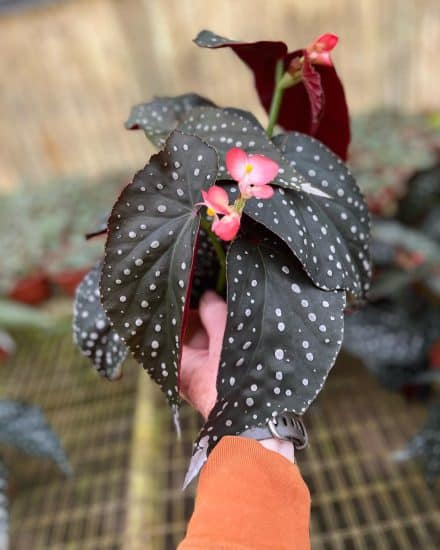
The angel wing begonia (Begonia x corallina) is a perennial flowering plant native to South America that made its way worldwide with the help of renowned flower breeder Eva Gray.
You may have heard it called Begonia ‘Corallina de Lucerna‘ – that’s because Eva’s experiments with begonias involved crossing two kinds: Begonia coccinea ‘lucerna’, which features thick stems and relatively unadorned green leaves, and Begonia aconitifolia, a more delicate variety where this angel gets its silvery metallic leaf wings.
When cared for correctly its delicate blooms cascade in drooping clusters. They feature large, pointed, deep-green or variegated leaves adorned with silver markings, and petite yet bold blooms of white, pink, and red.
Varieties
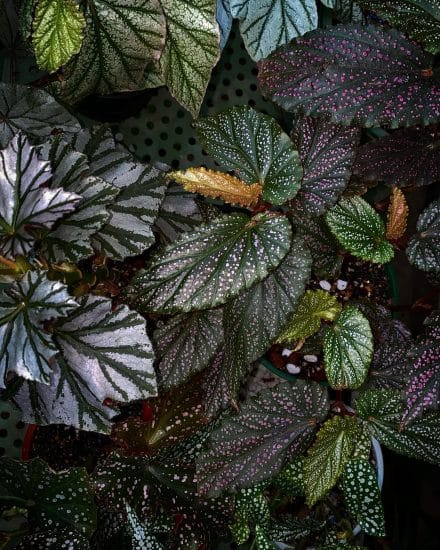
- Medora Angel Wing variety has deep green foliage with silver veins and light pink flowers for a bright splash of color.
- Pink Angel Wing offers grayish-green foliage with deep pink veins, white or pink blossoms.
- Spotted Angel Wing Begonia has silvery leaves and pink flowers.
- Begonia ‘Super Cascade’ variety is similar to the Spotted angel wing but with white or pinkish-white blooms and a trailing habit.
- Begonia ‘Apricot Shades’ offers bright orange blossoms, dark green foliage with silver veins, and a mounding habit.
A flowering plant
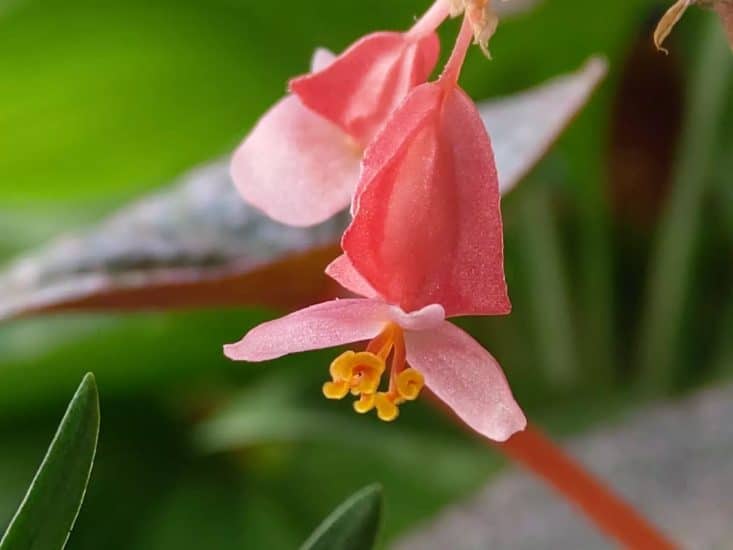
What really makes angel wing begonias stand out are their poignant clusters of flowers. From shades of pink, red, orange, yellow, and white to an array of sizes that can measure up to 3 inches in width – these blooms make for an enchanting sight.
Flowers grow easily in the spring and are a great indication that you’ve nailed the humidity and watering frequency.
If you’re having trouble with your angel wing begonia flowers showing up, don’t worry because we’ll give you all the care ingredients necessary to make them a certainty.
Light
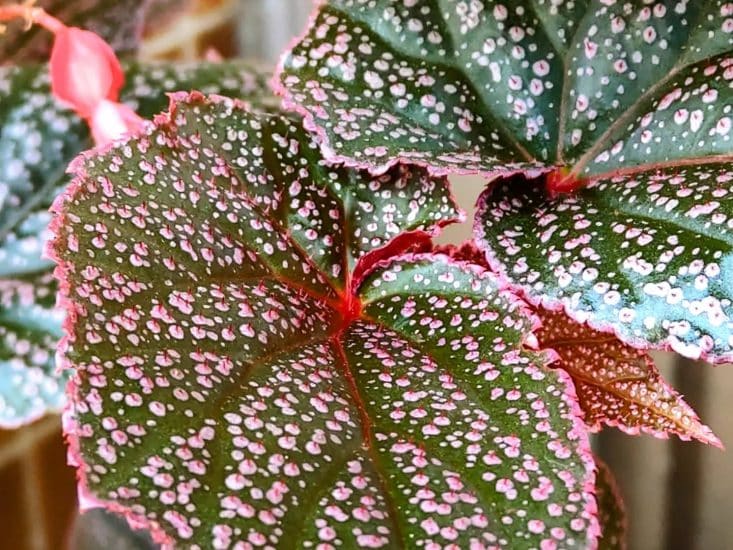
Angel wing begonia care begins with the essential: light.
They can tolerate a pretty decent amount of direct light. Not so much that I’d recommend a south-facing window, but especially in the winter when the light is weaker angel wing begonias can tolerate a few hours a day.
Just make sure it’s at least three feet away from the window to avoid sunburned leaves. Too much direct sunlight can also cause leaves to yellow and become scorched or curl up and drop off completely. Not ideal.
If the plant isn’t receiving enough bright light, there’s a few things you can check for like elongated stems, overcrowded leaves, and smaller-than-usual leaves with fewer blooms.
Tips:
- Angel wing begonias need bright light, ideally indirect.
- Rotate your plant regularly to ensure all sides receive sunlight.
- Extended direct sunlight can burn and damage your plant’s leaves.
Water
Watering an angel wing begonia plant first starts with the soil: insert a finger around 1-2 inches down. If it’s damp, you can wait a bit before watering. If it’s dry bring out the watering can.
So how else can you tell if you’re hitting the target with water?
Signs of overwatering are yellowing of the leaves and drooping plants. You might also notice fungal growth or a sour smell coming from the soil. If you do, let your soil get a bit drier before watering again.
Signs of underwatering include dry, yellow spots on the leaves, edges getting crispy, and overall wilting.
Tips:
- Water your Angel wing begonia around the base when you notice the top 1-2 inches of the soil are dry.
- When you water, avoid getting water on the leaves as this can cause fungal diseases, and water slowly so that the soil is saturated throughout.
Temperature and humidity
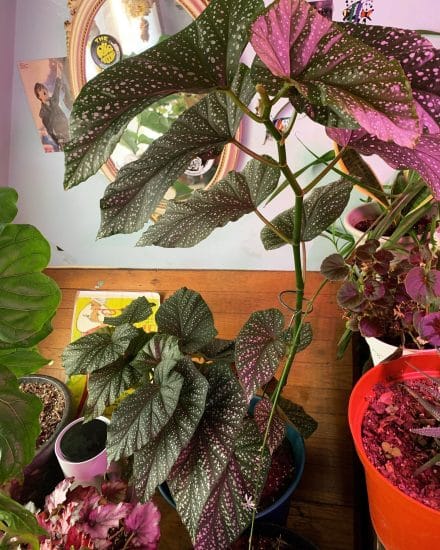
Growing angel wing begonias can involve a bit of compromise.
Plant placement for lighting and watering frequency don’t really inconvenience us all that much. Temperature and humidity can be where the real challenge begins.
So, let’s start with temperature. angel wing begonias like things balmy, like a day in the tropics. A perfect range for them is anywhere between 65 and 80 degrees Fahrenheit. Colder than 50 degrees is a big no-no, so be sure not to put your plant near a drafty window or air conditioner.
Humidity is just as important as temperature — it’s the key to giving your angel wing begonia the tropical environment it loves. To make sure the humidity level stays between 50 and 70%, try using a pebble tray filled with water or a small humidifier to regulate the moisture around your plant.
Alternatively, you can group together several houseplants in an area that is away from radiators or vents so they can create their own microclimate.
(Tip: It will be a bit warmer near your windows when they receive light, so don’t just measure the ambient room temperature.)
Soil and planting
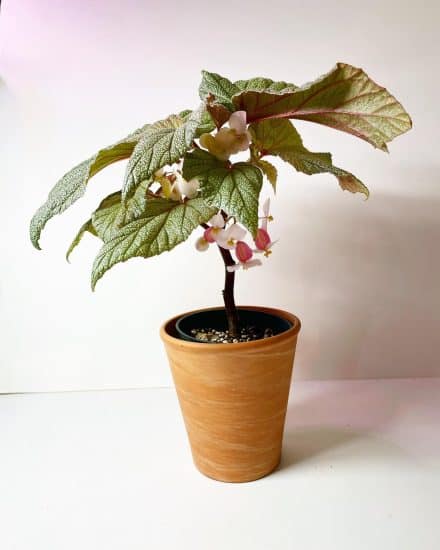
Soil choices will depend on your local climate, but one thing is for sure: garden soil just doesn’t work for houseplants. Ideally, you’d use potting soil enriched with perlite or LECA. This soil should hold moisture while still allowing for adequate airflow and water drainage.
For potting angel wing begonias, choose a slightly larger container, gently remove the root ball, and add new soil before returning the root ball to the new pot. Each spring (or if you notice roots emerging from the drainage holes), check to see if it’s time to report your angel wing begonia. Your container does have drainage holes, right?
(Note: don’t repot if your begonia is flowering, as this can cause flowers to fall.)
Propagation guide
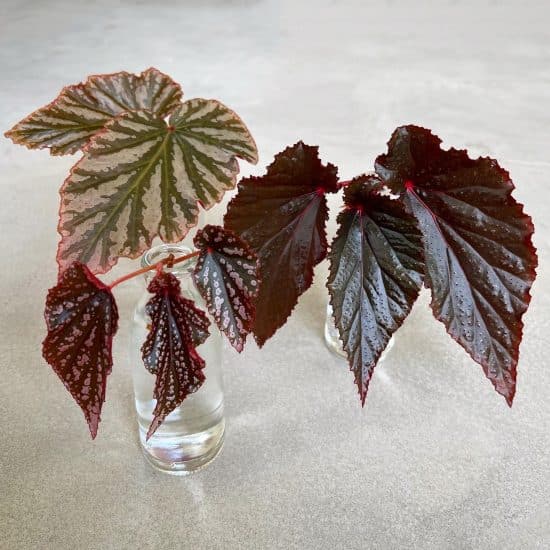
For propagating angel wing begonias, we recommend using stem cuttings. Many people ask about seeds, but because these are exclusively hybrids you’ll want to stick to cutting these sturdy stems.
Two options to consider when you grow angel wing begonias: water propagation and soil propagation. Both methods work, but a bit differently.
Water propagation is a great choice if you want to monitor your progress as you go. Keep the jar in indirect sunlight, checking it regularly for visible root growth. When the root system is visible and healthy, you can then move the cutting to a pot with moist, well-draining soil.
Soil propagation is more of a set-it-and-forget-it method, and you’ll want to use potting mix with perlite or another additive to keep it light and uncompacted for these new roots.
We’ll cover how to propagate angel wing begonias in soil:
- Select healthy cuttings that have 3 or more sets of leaves, Make sure the mother plant has enough leaves to remain healthy after the cuttings are taken. You don’t want the included leaves to be discolored or compromised.
- Using sharp scissors or pruning shears, make a 45-degree angle cut below the third set of leaves.
- Dip the cutting into an auxin-containing rooting hormone or rooting stimulant to help promote root formation (optional)
- Plant the cutting in potting soil and keep the soil moist. You can also place a plastic dome over the pot to help maintain humidity.
- Place the pot in an area with plenty of indirect light.
- Check the cutting every few days and water as needed.
Common issues
Let’s get into the most common issues we see with Angel Wing bagonia plants. They all have pretty easy solutions, so if you’re reading this because you’re experiencing one of these issues don’t fret!
If you do have damaged or dead leaves, this is a great opportunity to prune your angel wing begonia. These yellow leaves can become a nucleation point for fungal infections or food for pests, so clip-and-toss ’em!
Brown Leaf Tips
Browning leaf tips are a common problem for angel wing begonia plants. This issue is typically caused by poor water quality, as the minerals present in hard water can damage the delicate leaves of the plant. You can try rainwater, filtered tap water, or distilled water instead. This can also be caused by excessive fertilizer, so make sure to dilute.
Angel wing begonia flower issues
Angel wing begonias really need a lot of indirect light and the proper humidity to reward us with beautiful, vibrant flowers.
If you aren’t seeing flowers, or they’re dying off quickly, make sure the soil is drying out completely between waterings, that it’s not getting more than 5 hours a day of direct sun, and that the humidity levels are at least 40%.
Diseases and pests
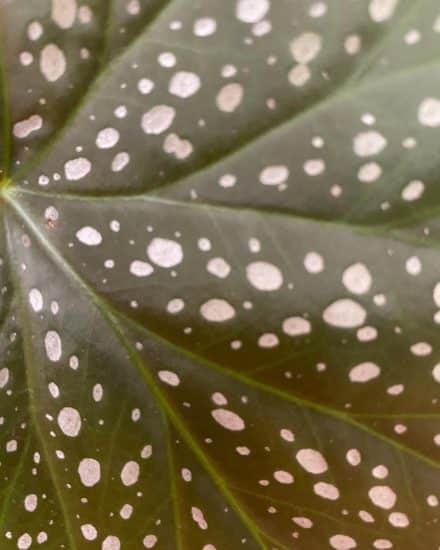
As we mentioned above about pruning, clipping off weaker/dying leaves is a great way to keep pests and fungus from being attracted to your plant. If they’ve still decided to make an appearance, all is not lost.
Fungal Issues: Fungal issues such as bacterial leaf spot, powdery mildew, or brown rot can be problematic for angel wing begonia. Symptoms of fungal issues include yellowing of leaves, discoloring on leaves and stems, and eventual wilting. To prevent or treat a fungal issue, ensure there’s enough indirect sunlight, avoid overwatering, and water the plant at its base to keep the foliage dry. If the fungus persists, you may need to apply a fungicide.
Root Rot: Root rot can occur when the roots of an angel wing begonia sit in soggy, water-logged soil. If you notice wilting, yellowing of the leaves, and brown spots, your plant may have a root rot issue. Let the soil thoroughly dry out and don’t water again until it’s dry to the touch. Pull the plant out of its soil and check the roots to see if they’re slimy or mushy – if they are, you’ll need to cut them off. If the issue persists, repot the plant with fresh aerated soil and let it thoroughly dry between waterings.
Pests: Angel wing begonia is susceptible to bug infestations such as aphids or spider mites. To detect bugs, inspect the plant’s leaves. If bugs are present, isolate the Begonia to prevent them from spreading to other houseplants. To treat an infestation, use a mild insecticide such as neem oil.
Conclusion
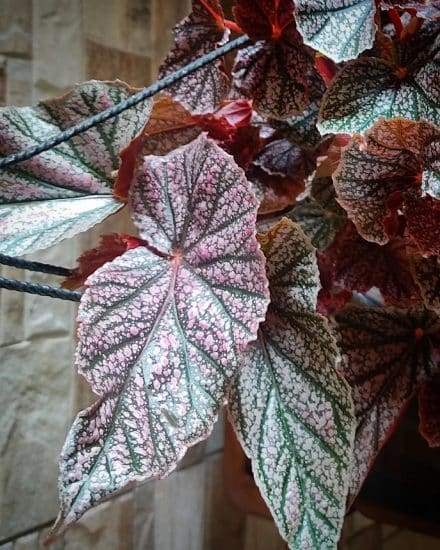
Angel wing begonia care that’s just right rewards us with beautiful flowers that grow in a variety of bright colors ranging from pale creams to vivid reds and pinks.
Growing angel wing begonias is pretty easy, whether you’re taking care of your first plant or propagating some babies for your friends. As far as indoor plants go, they offer attractive blooms, glossy green leaves with specs of silver, and look sporty in clay pots.
Give them frequent watering (checking to make sure the soil is dry), keep them away from heating vents, and larger plants especially need good air circulation.
If you hit the mark you’ll have a plant that looks good year-round.
FAQ
Are Angel Wing Begonias rare?
Nope, angel wing begonias aren’t considered to be rare on their own, but some angel wing begonia varieties are becoming hard to find. If you aren’t too picky, you can usually pick one up at a local garden center. If you’re looking for something a bit more esoteric, you’ll have to check online marketplaces and have one shipped.
How long do Angel Wing Begonias live?
I’ve heard of an angel wing begonia plant living 20+ years in the right conditions, Begonia rex lasts only 2-3 years. If you’re worried about its lifespan and already taking the best care you can, you can always propagate a few more and elongate the lifespan that way!
How do you keep angel wing begonia bushy?
You’ll want to regularly prune your angel wing begonia, removing any dead or damaged leaves all the way to the stem (you can trace them down). You can do the same with leggier growth, and to keep it compact you’ll want to ensure it has plenty of access to indirect sunlight as it grows.
How do I get my angel wing begonia to bloom?
A blooming angel wing begonia is a sign that you’ve gotten its growing conditions just right. Angel wing begonias prefer bright, indirect light and a well-draining soil. If you’re still having issues, try using some dilute fertilizer every other month to start in the growing season.
Do Angel wing begonias like to be misted?
Angel wing begonias, like most tropical plants, don’t do all that well with moist leaves. If you want to clean dust off, I recommend using a damp cloth instead. If you’re looking to raise the local humidity you can instead try clustering plants, placing it near a humidifier or in a naturally humid location like a bathroom.
Trust me, you don’t want any issues with fungus.

